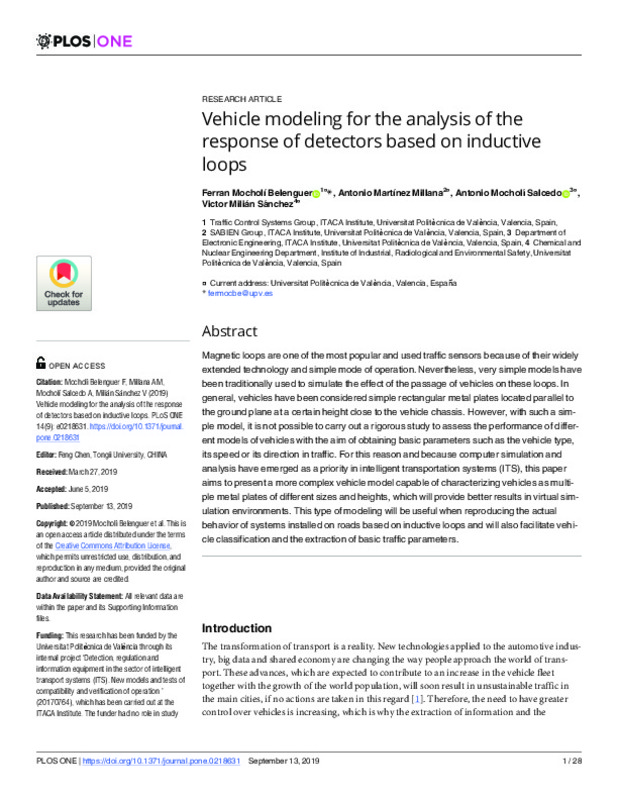Anderson, R. L. (1970). Electromagnetic loop vehicle detectors. IEEE Transactions on Vehicular Technology, 19(1), 23-30. doi:10.1109/t-vt.1970.23428
Prucha MJ, and View M. Inductive loop vehicle presence detector. U.S. Patent 3 576 525, Apr. 27, 1971.
Koerner RJ, and Park C. Inductive loop vehicle detector. U.S. Patent 3 989 932, Nov. 2, 1976.
[+]
Anderson, R. L. (1970). Electromagnetic loop vehicle detectors. IEEE Transactions on Vehicular Technology, 19(1), 23-30. doi:10.1109/t-vt.1970.23428
Prucha MJ, and View M. Inductive loop vehicle presence detector. U.S. Patent 3 576 525, Apr. 27, 1971.
Koerner RJ, and Park C. Inductive loop vehicle detector. U.S. Patent 3 989 932, Nov. 2, 1976.
Patrick HM, and Raymond JL. Vehicle presence loop detector. U.S. Patent 4 472 706, Sep. 18, 1984.
Clark MAG. Induction loop vehicle detector. U.S. Patent 4 568 937, Feb. 4, 1986.
Liu, K., Jia, J., Zuo, Z., & Ando, R. (2018). Heterogeneity in the effectiveness of cooperative crossing collision prevention systems. Transportation Research Part C: Emerging Technologies, 87, 1-10. doi:10.1016/j.trc.2017.12.013
Peng, Y., Jiang, Y., Lu, J., & Zou, Y. (2018). Examining the effect of adverse weather on road transportation using weather and traffic sensors. PLOS ONE, 13(10), e0205409. doi:10.1371/journal.pone.0205409
Liu, K., Cui, M.-Y., Cao, P., & Wang, J.-B. (2016). Iterative Bayesian Estimation of Travel Times on Urban Arterials: Fusing Loop Detector and Probe Vehicle Data. PLOS ONE, 11(6), e0158123. doi:10.1371/journal.pone.0158123
Ki, Y.-K., & Baik, D.-K. (2006). Vehicle-Classification Algorithm for Single-Loop Detectors Using Neural Networks. IEEE Transactions on Vehicular Technology, 55(6), 1704-1711. doi:10.1109/tvt.2006.883726
Zheng, Z., Wang, C., Wang, P., Xiong, Y., Zhang, F., & Lv, Y. (2018). Framework for fusing traffic information from social and physical transportation data. PLOS ONE, 13(8), e0201531. doi:10.1371/journal.pone.0201531
Pursula M and Kosonen I. Microprocessor and PC-based vehicle classification equipments using induction loops. Proceedings of the IEEE Second International Conference on Road Traffic Monitoring and Control; pp. 24–28, 1989.
Gajda J, Sroka R, Stencel M, Wajda A, and Zeglen T. A vehicle classification based on inductive loop detectors. Proceedings of the IEEE Instrumentation and Measurement Technology Conference, Budapest; pp. 460–464, 2001.
Nihan, N. L. (2000). Evaluation of forced flows on freeways with single-loop detectors. Journal of Advanced Transportation, 34(2), 269-296. doi:10.1002/atr.5670340206
Ametha J, Tumer S, and Darbha S. Formulation of a new methodology to identify erroneous paired loop detectors. Proceedings of the IEEE Intelligent Transportation Systems, Oakland; pp. 591–596, 2001.
Ki, Y.-K., & Baik, D.-K. (2006). Model for Accurate Speed Measurement Using Double-Loop Detectors. IEEE Transactions on Vehicular Technology, 55(4), 1094-1101. doi:10.1109/tvt.2006.877462
Tang, J., Zou, Y., Ash, J., Zhang, S., Liu, F., & Wang, Y. (2016). Travel Time Estimation Using Freeway Point Detector Data Based on Evolving Fuzzy Neural Inference System. PLOS ONE, 11(2), e0147263. doi:10.1371/journal.pone.0147263
Tok A, Hernandez SV, and Ritchie SG. Accurate individual vehicle speeds from single inductive loop signatures. Proceedings of 88th Annual Meeting of the Transportation Research Board, National Research Council, Washington, D.C, USA, 2009, paper 09–3512.
Hilliard SR. Vehicle speed estimation using inductive vehicle detection systems. United States Patent 6999886, Feb. 2003.
Gajda, J., Piwowar, P., Sroka, R., Stencel, M., & Zeglen, T. (2012). Application of inductive loops as wheel detectors. Transportation Research Part C: Emerging Technologies, 21(1), 57-66. doi:10.1016/j.trc.2011.08.010
Marszalek Z, Sroka R, Zeglen T. Inductive loop for vehicle axle detection from first concepts to the system based on changes in the sensor impedance components. Proceedings of 20th international conference on methods and models in automation and robotics, 24–27, August 2015, Miedzyzdroje, Poland, pp 765–769.
Arroyo Núñez JH, Mocholí Salcedo A, Barrales Guadarrama R, and Arroyo Nuñez A. Communication between magnetic loops. Proceedings of 16th World Road Meeting, Lisbon, Portugal, May 2010.
Gajda J and Burnos P. Identification of the spatial impulse response of inductive loop detectors. IEEE International Instrumentation and Measurement Technology Conference (I2MTC) Proceedings, 2015, pp. 1997–2002.
Klein LA, Gibson DRP, and Mills MK. Traffic Detector Handbook. FHWAHRT-06-108. Federal Highway Administration, U.S. Department of Transportation 2006.
Mills MK. Inductive loop system equivalent circuit model. Proceedings of the 39th Vehicular Technology Conference, May 1989, pp. 689–700.
Mills MK. Self-Inductance Formulas for Multi- Turn Rectangular Loops Used with Vehicle Detectors. 33rd IEEE VTG Conference Record, May 1983, pp. 64–73.
Mocholi-Salcedo, A., Arroyo-Nunez, J. H., Milian-Sanchez, V. M., Palomo-Anaya, M. J., & Arroyo-Nunez, A. (2017). Magnetic Field Generated by the Loops Used in Traffic Control Systems. IEEE Transactions on Intelligent Transportation Systems, 18(8), 2126-2136. doi:10.1109/tits.2016.2632972
Mocholí Belenguer, F., Mocholí Salcedo, A., Guill Ibañez, A., & Milián Sánchez, V. (2019). Advantages offered by the double magnetic loops versus the conventional single ones. PLOS ONE, 14(2), e0211626. doi:10.1371/journal.pone.0211626
Chen, F., Chen, S., & Ma, X. (2018). Analysis of hourly crash likelihood using unbalanced panel data mixed logit model and real-time driving environmental big data. Journal of Safety Research, 65, 153-159. doi:10.1016/j.jsr.2018.02.010
Ma, X., Chen, S., & Chen, F. (2017). Multivariate space-time modeling of crash frequencies by injury severity levels. Analytic Methods in Accident Research, 15, 29-40. doi:10.1016/j.amar.2017.06.001
[-]









